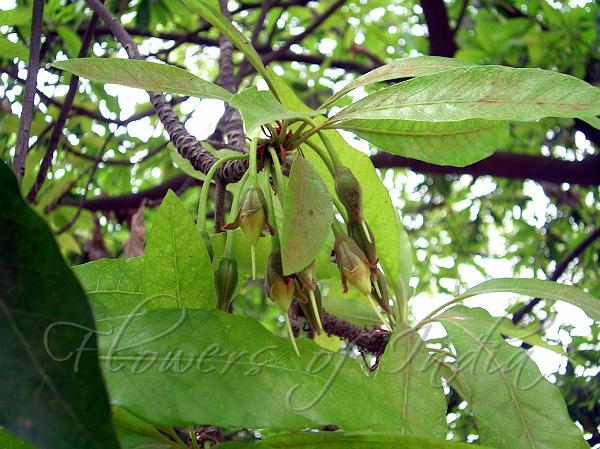|
| South Indian Mahua |
|

|

| File size | 976969 |
| Original date | 4/1/08 11:58 AM |
| Resolution | 2048 x 1536 |
| Flash | Flash did not fire, auto |
| Focal length | 8.0mm |
| Exposure time | 1/112s |
| Aperture | 3.2 |
| Focus Distance | |
| Metering Mode | Partial |
| Camera make | NIKON |
| Camera model | E3700 |
| Sensor type |
|
|
|
Photo: |
Botanical name: Madhuca longifolia var. longifolia Family: Sapotaceae (mahua family)
South Indian Mahua is a variety of Mahua which is predominently found in
South India. It differs from the usual Mahua in that its leaves are narrower.
Mohua is one of the most important of Indian forest trees, not because
it may possess valuable timber - and it is hardly ever cut for this
purpose - but because of its delicious and nutritive flowers. It is a
tree of abundant growth and, to the people of Central India, it provides
their most important article of food as the flowers can be stored
almost indefinitely. It is large and deciduous with a thick, grey bark,
vertically cracked and wrinkled. Most of the leaves fall from February
to April, and during that time the musky-scented flowers appear. They
hang in close bunches of a dozen or so from the end of the gnarled,
grey branchlets. The reddish young leaves with the flower clusters look very
attractive. The flower stalks are green or pink and furry, about
5 cm. long. The plum-coloured calyx is also furry and divides into four
or five lobes; within them lies the globular corolla, thick, juicy and
creamy white. Through small eyelet holes at the top, the yellow anthers
can be seen. The stamens are very short and adhere to the inner surface
of the corolla; the pistil is a long, protruding green tongue. It is at
night that the tree blooms and at dawn each short-lived flower falls to
the ground. A couple of months after the flowering period the fruit
opens. They are fleshy, green berries, quite large and containing
from one to four shiny, brown seeds.
Medicinal uses: Medicinally the tree is very valuable. The bark is used to cure leprosy
and to heal wounds, tne flowers are
prepared to relieve coughs, biliousness and
heart-trouble while the fruit is given in cases of consumption and blood
diseases.
Medicinally the tree is very valuable. The bark is used to cure leprosy
and to heal wounds, tne flowers are
prepared to relieve coughs, biliousness and
heart-trouble while the fruit is given in cases of consumption and blood
diseases.
Medicinal uses:
 Medicinally the tree is very valuable. The bark is used to cure leprosy
and to heal wounds, tne flowers are
prepared to relieve coughs, biliousness and
heart-trouble while the fruit is given in cases of consumption and blood
diseases.
Medicinally the tree is very valuable. The bark is used to cure leprosy
and to heal wounds, tne flowers are
prepared to relieve coughs, biliousness and
heart-trouble while the fruit is given in cases of consumption and blood
diseases. | Identification credit: Tabish | Photographed in Shanti Van, Delhi. |
• Is this flower misidentified? If yes,